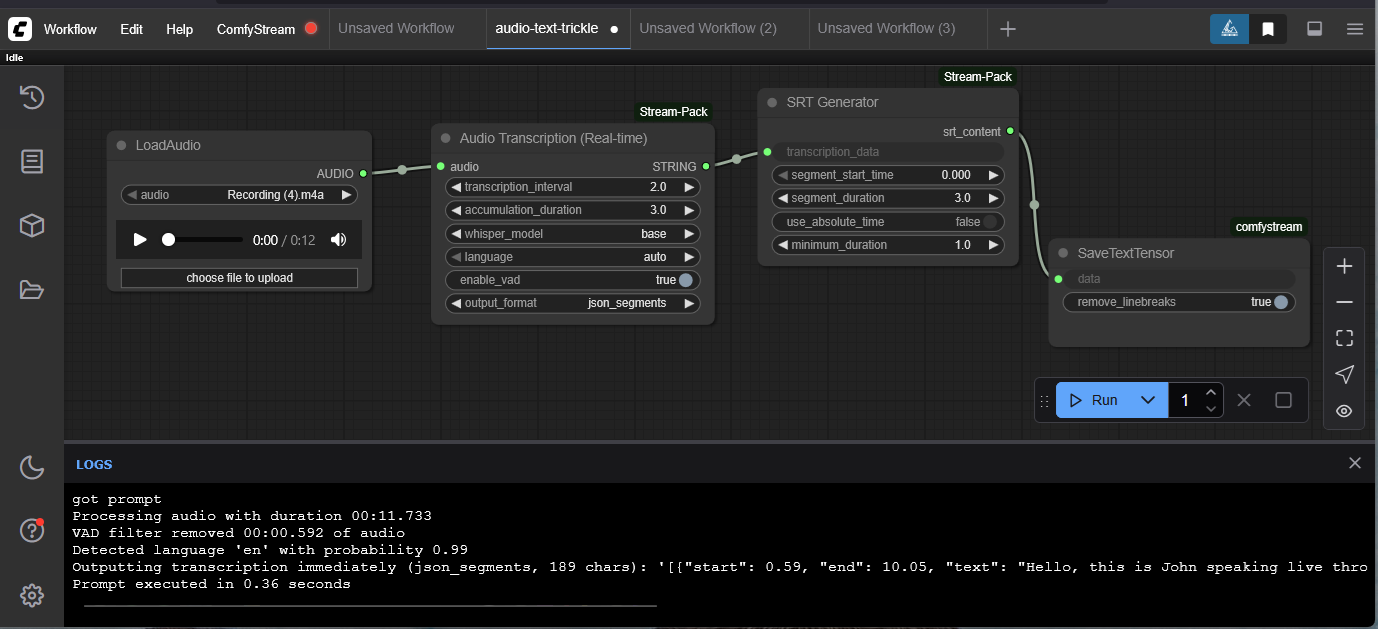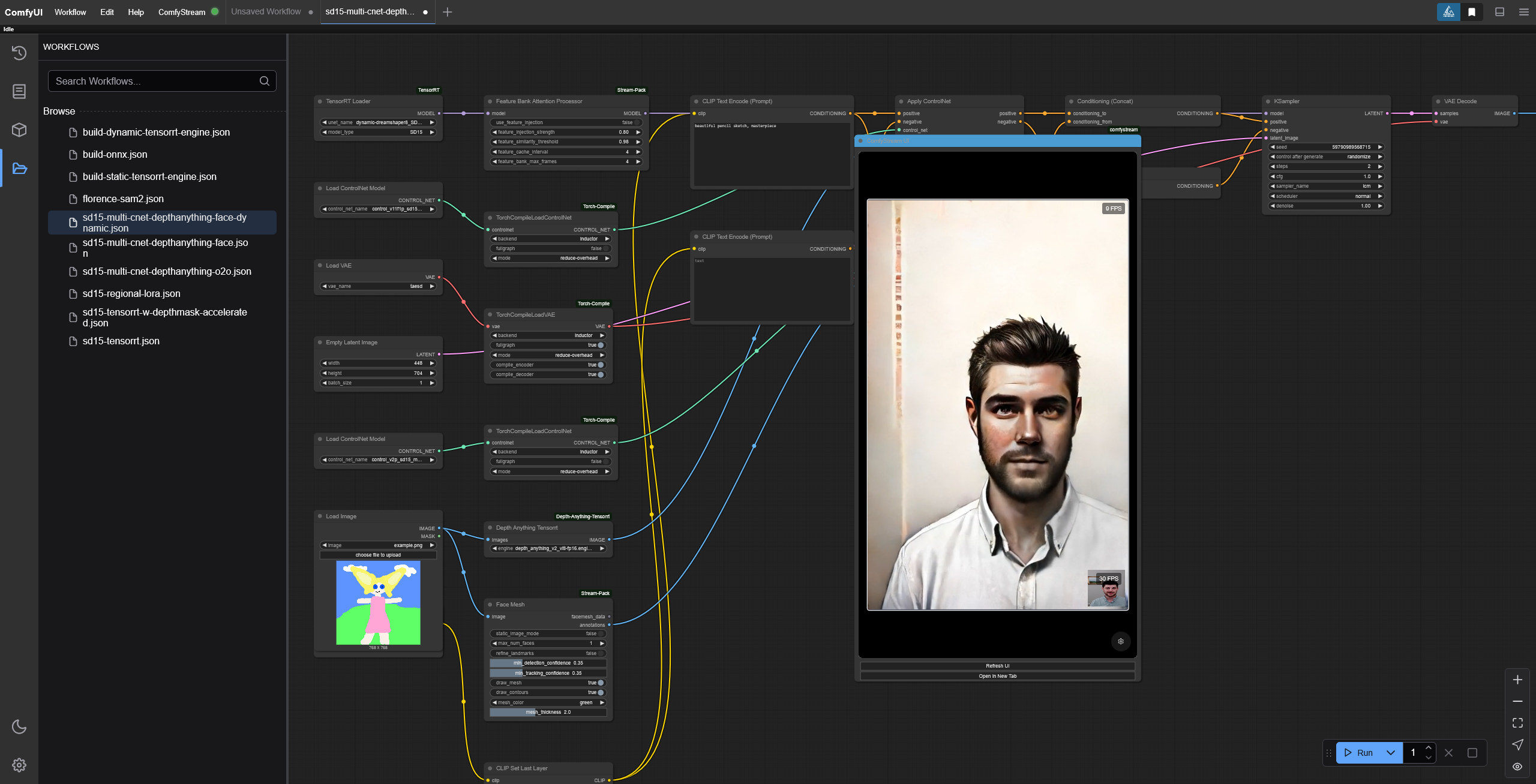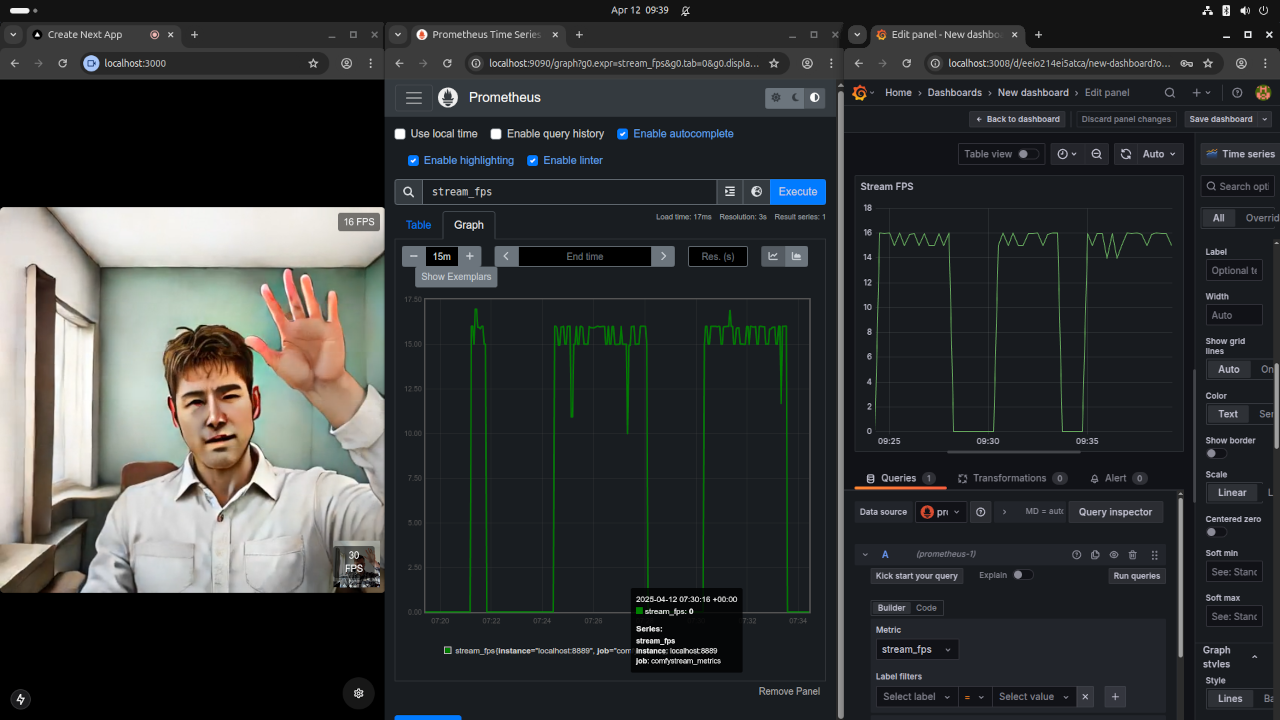BYOC Workflows, ComfyUI-Manager, and Performance Enhancements
This release introduces significant enhancements for production deployments with pytrickle support for Bring Your Own Container (BYOC) workflows, ComfyUI-Manager integration with performance-optimized blacklist loading, and improved model efficiency using TAESD safetensors and all documentation links now points correct site.New Features
- BYOC Workflows with Pytrickle: Integrated pytrickle support enabling ComfyStream workflows as Bring Your Own Containers
- ComfyUI-Manager Integration: Added ComfyUI-Manager with blacklist loading for improved performance and easier custom node management
- FasterLivePortrait Support: Enhanced opencv-cuda for compatilibity with Python 3.12 and resolved issues with FasterLivePortrait integration
- Model Efficiency and Security: Switched to TAESD safetensors format (replacing .pth files) for better model loading efficiency and security from pickled files.
UI & Documentation
- Refactored UI Popup: Removed inline HTML/JS code for a cleaner, more maintainable codebase
- Updated Documentation Links: All references now point to the official documentation site
Performance & Stability
- Input Timeout Protection: Added timeouts to LoadTensor and LoadAudioTensor nodes to prevent hanging
- Enhanced Error Logging: Improved exception logging for input-related issues
- OpenCV-CUDA Compilation: GitHub workflow for automated opencv-cuda compilation
- Dependency Updates:
- Upgraded pytrickle to v0.1.4
- Replaced deprecated pynvml with nvidia-ml-py
- Updated Next.js from 15.2.4 to 15.5.3
Bug Fixes
- Fixed pyproject.toml metadata for ComfyUI registry compatibility
- Corrected sample rate in audio transcription workflows
- Added missing Cairo and Pango development libraries in Docker images
- Updated BYOC capability name in launch configurations
- Removed unnecessary GitHub workflow triggers
Audio Driven Workflows and Text Outputs


New Features
- Support for audio driven workflows
- Text outputs via RTC data channel
- Real-time text transcription demo with Whisper
Improvements
- Upgraded ComfyStream to support the latest ComfyUI version
- Python version bumped to 3.12 for compatibility
- Fixes for custom node imports, prompt conversion, and launch configurations
New Contributors
- @doctorpangloss
RTX 5090 Support and Infrastructure Improvements
This release adds support for NVIDIA’s latest RTX 5090 GPUs and includes significant infrastructure improvements for better development experience and deployment flexibility. The base image has been updated to support the latest CUDA and TensorRT versions.New Hardware Support
- RTX 5090 GPU Support: Full compatibility with NVIDIA’s latest Blackwell architecture
- Updated CUDA Requirements: Minimum supported driver version
NVIDIA 570.124.06withCUDA 12.8 - PyTorch Blackwell Support: Updated PyTorch for optimal performance on RTX 5090
Infrastructure & Developer Experience
- Entrypoint Flexibility: Added
--apiand--uiflags to entrypoint.sh for selective service startup - FasterLivePortrait Workflow: New workflow documentation for FasterLivePortrait integration
- Improved Container Stability: Fixed devcontainer loading issues and conda environment installation
- Better Volume Management: Enhanced volume mount for persistent storage across container restarts
Base System Updates
- CUDA 12.8 and TensorRT 10.12: Updated base to support newer compute capability GPUs.
- Dependency Stability: Pinned
numpy<2.0for consistent behavior across environments - Network Configuration: Fixed server manager host binding for proper network access
MPEG Stream Egress and OBS Integration
This release introduces token-gated MPEG stream egress capabilities, enabling direct OBS integration for live streaming workflows. Along with significant stability improvements through dependency pinning and bug fixes.New Features
- Token-Gated MPEG Stream Egress: External MPEG stream endpoint with authentication for secure access
- OBS Video Source Support: Demo page and direct OBS integration for capturing ComfyStream output in live streaming setups
- Separate OBS Tab: Dedicated interface for OBS-specific functionality and configuration
Stability & Performance
- Dependency Pinning: Pinned critical packages for improved stability:
- xformers==0.0.30
- pytorch==2.7.0
- onnxmltools==1.13.0
- Client API Fixes: Resolved
comfystream.client.update_promptslock issues and error handling - Build Process Optimization: Streamlined Docker workflows by removing separate build processes
Developer Experience
- Contributing Guide: Added comprehensive documentation for project contributors
- Volume Mount Improvements: Enhanced volume handling with proper —server flag qualification
- CI/CD Enhancements: Improved workflow triggers and build automation for ai-runner integration
Multi Resolution, Upscaling and Pipeline Integration

livepeer/comfyui-base:v0.1.0 and livepeer/comfystream:v0.1.0.New Features
- Multi-Resolution Support: Dynamic resolution handling with precompiled TensorRT engine examples supporting combinations of width/height from 448px to 704px
- Super Resolution Node: Enhanced image quality through OpenCV-based super resolution
- Exportable Pipeline Class: Access the
comfystream.pipelineclass to integrate ComfyStream directly into your applications
New Models
- Depth Anything V2: Integrated the large model variant with TensorRT compilation for improved depth mapping
Developer Experience
- Simplified Integration: Refactored package structure to make ComfyStream easier to import and use in custom applications
Enhanced Branding, Metrics & Developer Experience

Documentation and Branding
We launched the first version of the ComfyStream documentation site, complete with onboarding guides, node usage examples, and a dedicated Media Kit with official logos and branding assets.New Features
- Metrics and Stream Stats: Monitor performance in real time via Prometheus or API, with detailed FPS metrics
- Combo Panel (Experimental): Early UI for grouped node control
- Log Level Configuration: Adjust ComfyUI logging verbosity via environment variables
- Search Query Support: Quickly access preset queries to streamline stream startup
Improvements
- Performance Enhancements: Improved FPS and reduced latency
- Docker Build Optimization: Speeds up builds and ensures consistent environments
- Developer Tooling: Smoother setup with devcontainers, Ansible provisioning, and HTTPS support in VSCode
Bug Fixes
- Resolved Safari compatibility issues
- Fixed camera and microphone selection bugs
- Addressed audio input stability issues
- Fixed preview node display and rendering problems
ComfyStream Enters Public Alpha
